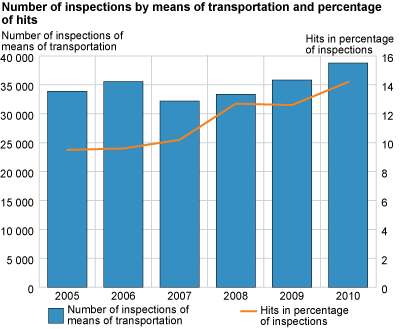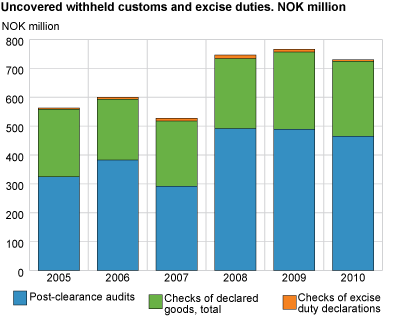Content
Published:
This is an archived release.
High inspection frequency in Norwegian Customs and Excise
In 2010, the activity in the Norwegian economy went up. This leads to an increase in the workload for the Norwegian Customs and Excise. The agency conducted more inspections than previous years and the percentage of hits has remained at a stable level.
Own production in the Customs and Excise, defined as the sum of compensation of employees and use of goods and services, amounted to NOK 1.4 billion in 2010. The costs increased by 5 per cent from 2009, which was a lower cost increase than in 2009 and 2008. The employees carried out 1 704 contracted man-years, adjusted for long-term leave; an increase of 2.2 per cent compared to 2009.
Increased number of border inspections - 24 000 inspections revealed smuggling attempts
In order to prevent illegal imports and exports of goods, the Norwegian Customs and Excise carries out border inspections of travellers, conveyances and goods. In 2010, 206 482 border inspections were conducted. As a result, 23 950 inspections revealed illegal imports or exports of goods. This yields a share of hits of 11.6 per cent. In comparison, the agency conducted 187 645 inspections, and the percentage of hits was 11.3. Hits as a percentage of inspections by means of transportation went up the most, and was 14.2 per cent in 2010.
High number of seizures
As a result of the border inspections, the agency conducted 33 600 seizures in 2010. A total of 818 cases were considered serious contraventions; an increase of 21.5 per cent compared to 2009.
The number of drug seizures exceeded 2 500, which is an all time high for the agency. Measured in volume, seizures of heroin, cannabis and amphetamine went somewhat down compared to 2009, while khat, narcotics tablets and cocaine increased. Seizures of merchandise with high tax levels, such as alcohol beverages, were at a higher level compared to previous years. A total of 510 281 litres of alcoholic beverages were confiscated in 2010, compared to 343 304 litres in 2009.
| Number of audits | Hits in per cent of audits | ||||||||||||||||||||||||||||||||||||||||||||||||||||||||||||||||||||||||||||||
|---|---|---|---|---|---|---|---|---|---|---|---|---|---|---|---|---|---|---|---|---|---|---|---|---|---|---|---|---|---|---|---|---|---|---|---|---|---|---|---|---|---|---|---|---|---|---|---|---|---|---|---|---|---|---|---|---|---|---|---|---|---|---|---|---|---|---|---|---|---|---|---|---|---|---|---|---|---|---|---|
| 2006 | 2007 | 2008 | 2009 | 2010 | 2006 | 2007 | 2008 | 2009 | 2010 | ||||||||||||||||||||||||||||||||||||||||||||||||||||||||||||||||||||||
| Checks of excise duty declarations | 551 | 538 | 578 | 548 | 585 | 36.8 | 43.5 | 49.0 | 48.0 | 47.5 | |||||||||||||||||||||||||||||||||||||||||||||||||||||||||||||||||||||
| Post-clearance audits | 1 302 | 1 166 | 1 317 | 1 493 | 1 538 | 61.5 | 67.7 | 69.5 | 70.4 | 63.8 | |||||||||||||||||||||||||||||||||||||||||||||||||||||||||||||||||||||
| Checks of declared goods, total | 180 821 | 178 800 | 174 480 | 175 995 | 183 330 | 38.2 | 38.2 | 38.2 | 37.9 | 35.2 | |||||||||||||||||||||||||||||||||||||||||||||||||||||||||||||||||||||
More economic audits - somewhat lower hit rate
The Customs and Excise Agency carries out different economic audits to ensure proper declaration and determination of customs duties and taxes.
Due to higher levels of trade, the amount of declarations reached 6 million in 2010; an increase of 408 624 declarations compared to 2009. The inspection frequency was higher in 2010 and the coverage measured by the number of audits in relation to the number of declarations remained at the same level as in 2009. A total of 183 330 declarations were inspected and 35.2 per cent revealed violations of varying severity. In comparison, 175 995 declarations were inspected in 2009 and hits in per cent of audits was 37.9.
Another type of economic control is checks of excise duty declarations. A total of 585 audits were conducted in 2010, compared to 548 in 2009. As in previous years, violations were uncovered in almost half of the inspected excise duty declarations.
In addition, the agency conducts post-clearance audits. A total of 1 538 inspections were carried out and 63.8 per cent revealed errors. Compared with 2009, the hits in percentage of inspection dropped 7 percentage points.
The economic controls uncovered withheld customs and excise duties totalling NOK 729.5 million. A total of 159 cases were considered to be serious contraventions.
NOK 192 billion in collected taxes and few outstanding claims
In 2010, Norwegian Customs and Excise collected taxes equal to NOK 192 billion. This amounted to about one-fifth of the total revenue in the central government’s fiscal account. Compared to 2009, where the collected taxes were low due to the international financial situation, the amount of collected taxes increased by NOK 12 billion.
As in 2009, the arrears in collection of taxes were low in 2010. A total of 99.84 per cent of the claims were paid, and the corresponding figure for 2009 was 99.87 per cent. Excluding arrears resulting from control claims, the agency collected 99.9 per cent of the claims in 2010.
Norwegian Customs and Excise and StatResNorwegian Customs and Excise is part of the Ministry of Finance. Organizationally, it is divided into a central directorate and six local customs regions. The responsibilities of the agency are to prevent illegal importation and exportation of goods, and to ensure that customs duties are correctly declared, assessed and paid in timely fashion. The object of StatRes is to present statistics on central government input, the results of this input in terms of activities and services, and the outcomes of the input. Norwegian Customs and Excise was included in StatRes in 2008. Input indicators measured in NOK are based on the central government’s fiscal account. Input indicators measured in man-years are based on Statistics Norway’s register-based employment statistics. Data regarding activities, services and outcomes are collected directly from Norwegian Customs and Excise. See About the statistics for further information. |
Contact
-
Statistics Norway's Information Centre
E-mail: informasjon@ssb.no
tel.: (+47) 21 09 46 42


